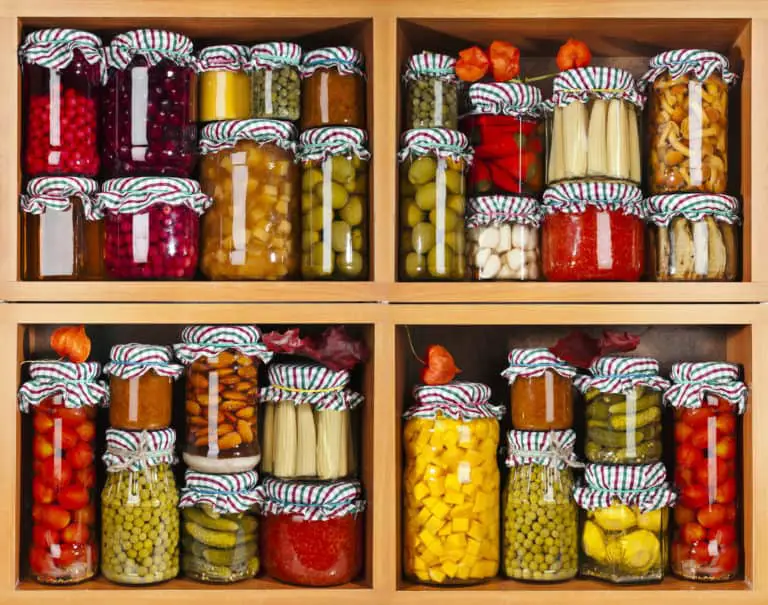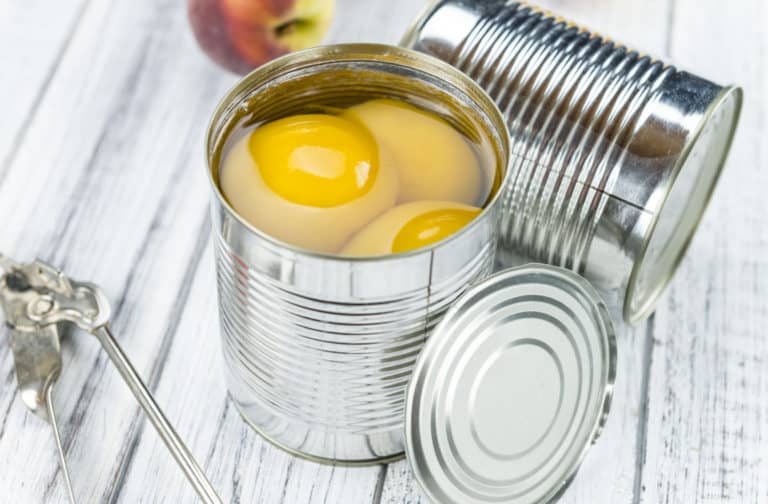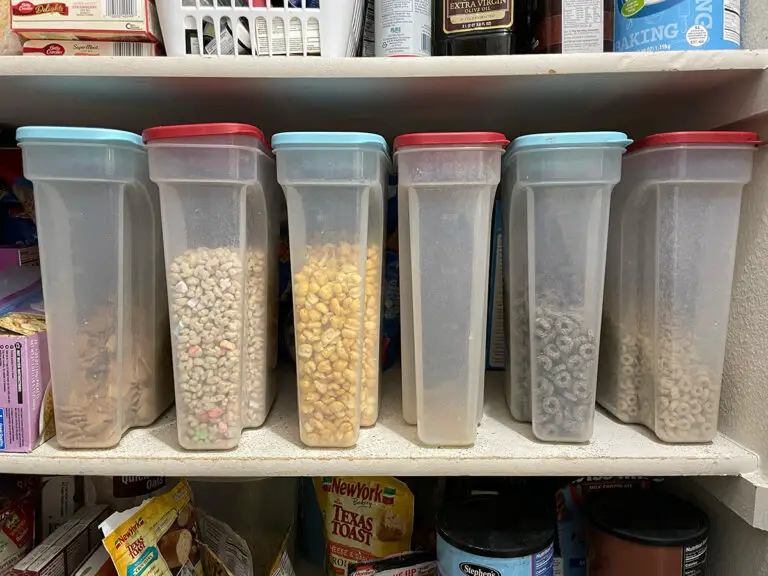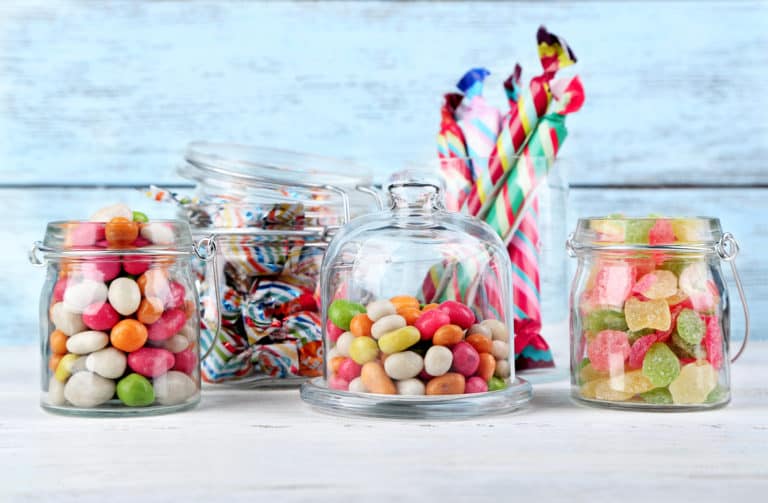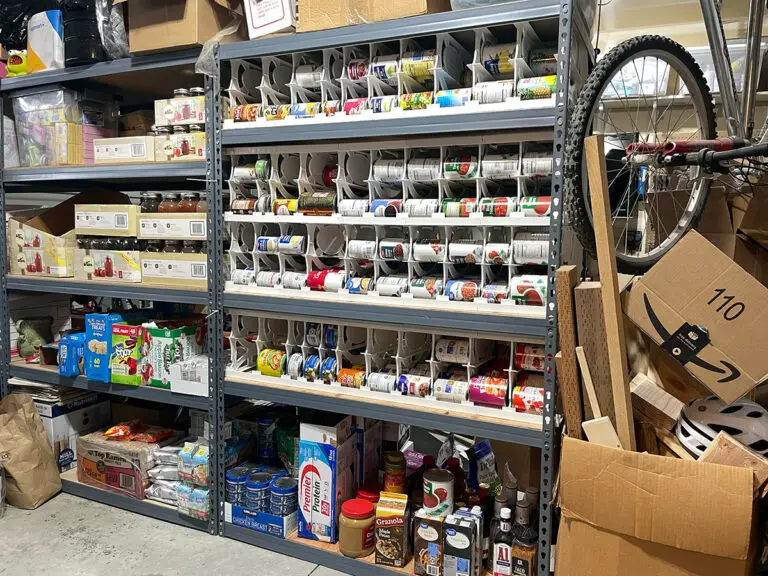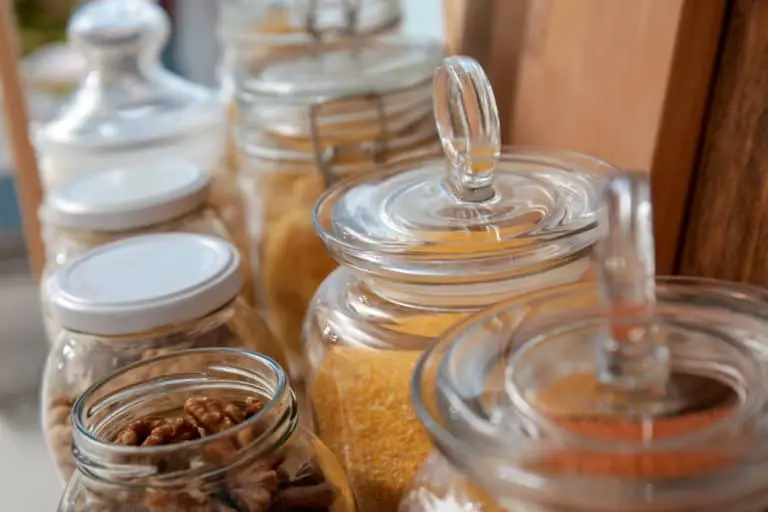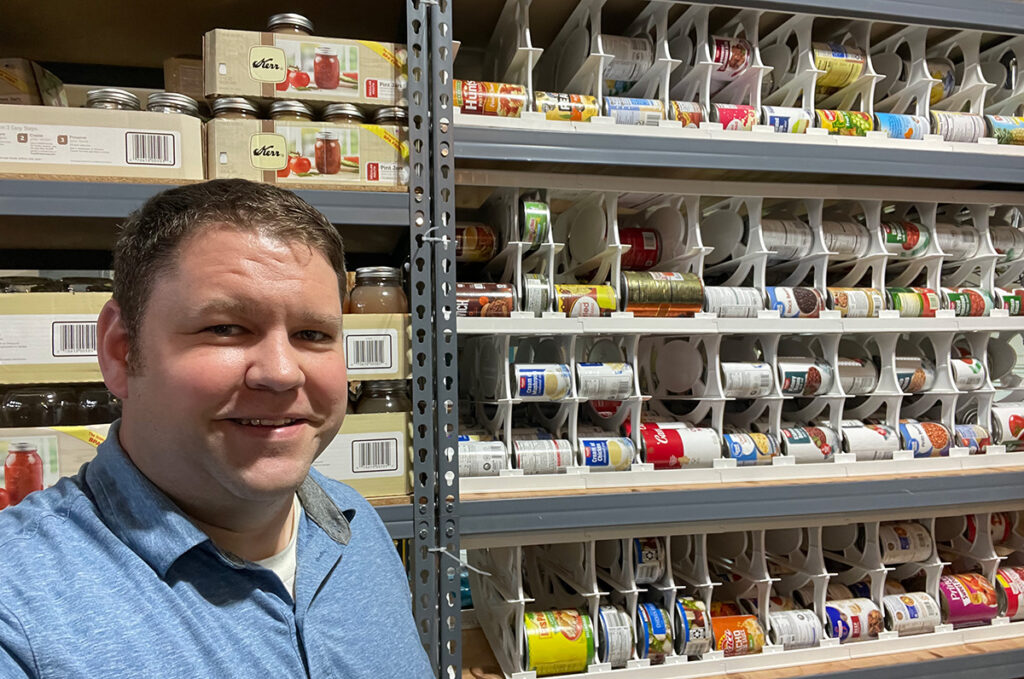
It’s great to have food stored so you can be prepared for an emergency. But how long does food last in storage?
Food storage should be built around hard grains like wheat, rice, and corn, which can last for over 10 years, and should include limited amounts of sugar, soft grains, and canned goods, which only last for 1-2 years. The lifespan of food storage products can be extended with additional treatment.
I know firsthand that it can seem daunting to build up food storage. But trust me, the best time to start building one is now. One easy way to get started when you’re overwhelmed is to add a couple of items each month to your grocery list. Within a year you’ll have a good amount of food stored.
Here are some tips to help you get started with your own food storage, as well as some things that can help extend the life of your food from several months to several years.
Food Storage Staples and How Long You Can Expect Them to Last
| Food Storage Item | Expected Shelf Life (From Store to Shelf) | Expected Shelf Life (Additional Treatment) |
| White/Red Wheat | 6 to 18 months | 10 to 30 years |
| Dried Corn | 5 to 10 years | 10 to 15 years |
| Whole Oats | 1 year | 10 to 15 years |
| White Flour | 3 to 8 months | 1 to 2 years |
| Wheat Flour | 2 to 5 months | 1 year |
| White Rice | 2 years | 10 to 30 years |
| Brown Rice | 3 to 6 months | 1 to 2 years |
| Dried Milk | 3 to 18 months | 3 to 5 years |
| Homemade Canned Goods | 1 to 2 years | 1 to 2 years |
| Storebought Canned Goods | 3 to 5 years | 8 to 10 years |
| Sugar | 2 years | Indefinite |
| Freeze Dried Food | 15 to 20 years | 25 to 30 years |
| Frozen Meat | 1 to 6 months | 5 to 18 months |
By looking at this chart, we can see some of the most common staples for food storage. You can also see from this chart how long you can expect each of these items to last with minimal prep work compared to how long they can last if you put in the time and effort to maximize their lifespan.
When building up your own food storage, there are a couple of things that you are going to want to consider. The first and most important thing to consider is that while you are planning to store food you may need for an emergency, you also need to actually eat the food, even if there isn’t an emergency.
Since you can expect grains to last several years it makes sense to buy them in large amounts, but less often. Food like flour or meat has a shorter shelf life so you should plan on buying less of them at a time, but you should also plan on eating and replacing them with newer food in your storage every couple of months.
Consider your food preferences when buying food to put into storage. If there is a certain food on this chart that you wouldn’t touch normally, you probably do not want to include several pounds of it in your food storage. Especially because you’ll want to go through it before it expires.
Set Up a System to Rotate Your Food Storage
The best way to keep your emergency food stash fresh without wasting anything is to set up a system of how you are going to eat, add, and replace food items to your food storage. This is particularly important for canned goods and anything with meat or milk. These food products have a shelf life of a couple of months making it very easy for them to be pushed to the back of your storage and go bad before you notice.
An easy way to do this is to use a “first in first out” system. This means that when you are taking items from your food storage you should use the oldest food first to prevent spoilage and waste. It also means that you will need to keep track of when you placed each item in the storage. This will prevent new items from being stacked in front of older items and potentially cause them to expire while buried on the shelf. To track each item’s age you can use a marker to write the date you bought them. Then when you’re grabbing something to eat from your food storage you can just look for the oldest items and take them first.
You should also make sure that you have a variety of food in your food storage. If the worst happens, and you do have to live off of your food storage for a long period of time you are not going to want to be eating the same thing every day. And plan to have a variety of foods with different shelf lives. If you only stock up on food that will expire within a year of being bought like milk or meat, you will constantly be replacing the food in your food storage, and you will not have any long-term storage if an emergency gets really dire.
What Categories to Have in Your Food Storage
For your food storage, you should plan on having three different kinds of food. The first is hard grains like wheat or dry corn. These items can last for more than 10 years if they are stored properly and can serve as the backbone of your food storage. The next are cooking staples like rice, oats, and flour. While they do not last as long as hard grains will, only several months to a year, they can add variety to the food you have in storage and are easy to use in small amounts before they expire. The final kind of food is canned goods. These include canned items from the store, anything you have canned on your own at home, as well as sauces and other products bought at the store.
You should be particularly careful with canned items which generally have a shorter shelf life. Most canned items will last a few months after buying them. It will take more management on your part to ensure that you buy the right amount of these food items and that you are using them before they go bad and the food is wasted.
With these overall guidelines in mind here are some more specific things that you can follow for the main types of food in your food storage.
The Differences in Hard and Soft Grains with Food Storage
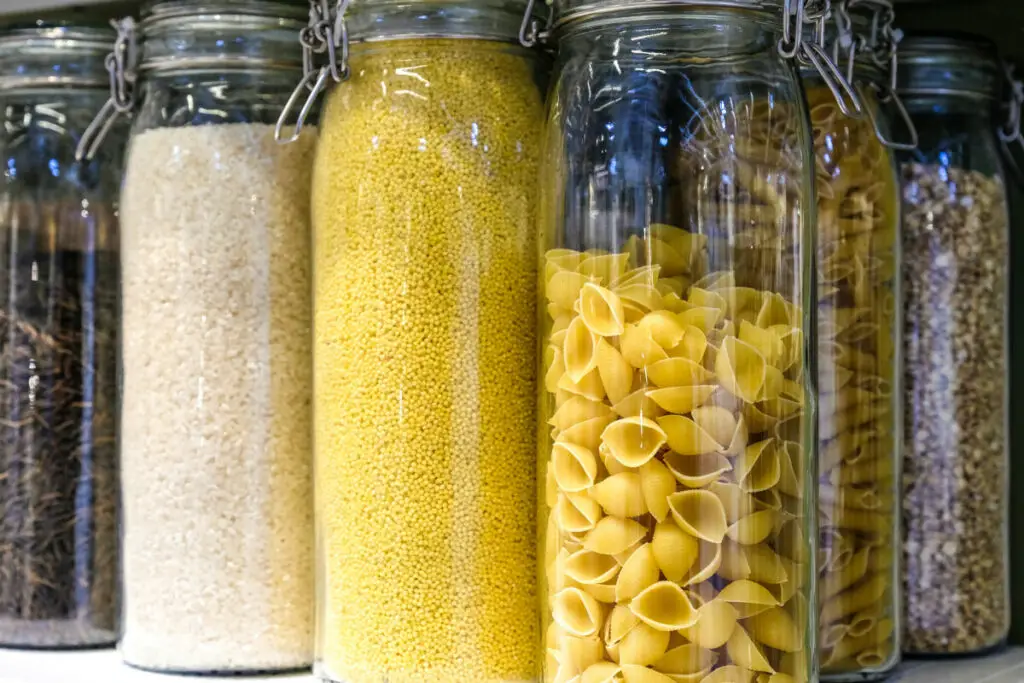
Let’s look at the first main staple: grains. Grains are an easy way to get some quick energy. They can also be used in a variety of food dishes so you won’t ever feel like you have to eat the same thing over and over again. There are two main categories of grains: hard and soft.
Hard grains include those that are contained within a hard shell like wheat and dried corn. Due to this hard shell, they have a longer shelf life and can last for over a decade if they are stored properly. This makes them an excellent foundation for your home food storage.
Soft grains on the other hand are more, well soft. This includes whole grains like oats as well as ground grains like various types of flour. Since they either lack a hard shell or the shell has been removed during processing these soft grains have a much shorter shelf life of a couple of months. However, they tend to be easier to handle than the hard grains so they still have a place in any food storage despite their shorter window of usability.
One thing that you may have noticed while reading the chart is that there is quite a big difference between these grains simply being left on a shelf in your home and taking extra preservation steps. These extra steps, while they might cost a little more money or take a little more of your time can literally add years onto your grains storage lifetime!
The biggest impact is on hard grains which can last up to 30 years after the proper steps are taken. Softer grains can benefit from these additional steps as well, but may only add a year or two onto the lifespan of flour or brown rice. \ So what are these additional treatment steps that you can take, and are they worth your time?
Storing Hard and Soft Grains
The first food preservation treatment is the environment you store the food in. The ideal environment is one that is dark, cool, clean, and dry. Food that is stored in plastic or paper is particularly vulnerable to heat and light so use other storage containers whenever possible. Keeping your food in a clean and dry area will also prevent the spread of insects, rodents, and mold in the food.
Bags and buckets of food should never be stored directly on the floor, particularly on bare concrete. They should be stored off the ground even if it is only a couple of inches up. Small homemade pallets can be an excellent way to store these items.
In general, paper and plastic are inferior ways to store food for long periods of time, while glass and metal are better for long-term storage. The absolute best way to store hard grains is to buy them sealed in metal No. 10 cans. These cans keep the grain sealed from outside light, air, and moisture providing the longest storage possible with some hard grains able to be stored for several decades in one of these cans. However, once you open the can the rest of the grain will decay quickly so you’ll need to plan on eating a large amount of these grains quickly.
Glass can be used to store grains, but common jars are a bit small to store a large amount of grain, especially that meant for a large family. Grains often come in plastic and paper bags which are alright for storage as long as you keep them in the proper environment. Expect grains stored in plastic bags to only have a 1 to 3-year lifespan.
I like to have a mix of easy access and long-period storage. One way to do that is to store grain in 5-gallon plastic food buckets. These buckets are easy to get into, but keep the grain safer from rodents and insects than a bag will. A way to extend the grain’s life even further is to place it in a mylar bag before putting it in a bucket. The mylar bag, similar to a plastic bag, can be filled and then sealed with an iron to keep air out. If you want to put in the extra effort and money, you can invest in oxygen absorbers. I definitely recommend it for long-term food storage. These absorbers can be placed in the bucket with the grains or in the storage room to preserve their shelf life even more!
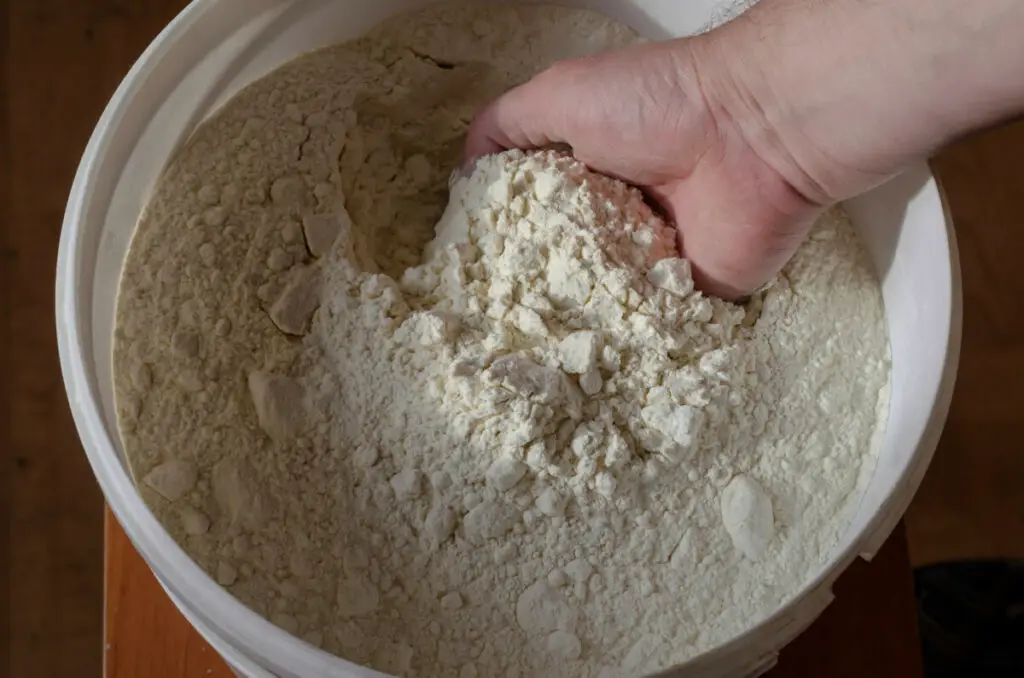
How to Handle Canned and Bottled Goods in Your Food Storage
Storing canned goods on the other hand can be considered similar to storing grains but there are some key differences that you will want to keep in mind as well.
With cans like grains, you still should make sure to store them in a cool, dark, and clean room. Cans also should not be stored directly on the floor since condensation from the floor can creep up and causes the cans or metal seals to rust. If you do see that any of the cans in your food storage have rusted, dispose of them without eating them. Like with grains the rule of thumb with canned containers is that metal and glass are the best options while plastic is inferior.
But there are some differences with cans. For one thing, you want to handle store-bought and homemade canned food differently. You can expect that canned food made by you will have a shorter shelf life than store-bought cans. Any canned goods that look visibly off or have a bad smell should be thrown away. And remember that canned food that is more acidic will have a shorter shelf life than products without a lot of acidity.
When storing large amounts of canned food make sure you have a system to track each can’s age. While it can be tedious to check expiration dates on each can, if you use a marker to write on the cardboard case the date they were bought you can save yourself a lot of trouble in the future. Remember to cycle canned food so that the oldest food is found near the front and eaten first.
Both store-bought and homemade canned food last several years with store-bought lasting up to five and homemade only lasting up to three years. Both types will see only a little longer lifespan if treatment steps are taken, so steps to extend your food’s lifespan should mostly be focused on grains and powdered foods which will see a big extension in their lifespan.
I hope this helps you set up a food storage system and routine that you can feel confident in!

